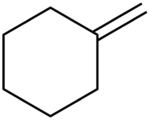Methylenecyclohexane
Methylenecyclohexane (IUPAC name: methylidenecyclohexane) is an organic compound with the molecular formula C7H12.
 | |
| Names | |
|---|---|
| IUPAC name
Methylidenecyclohexane | |
| Other names
Methylenecyclohexane | |
| Identifiers | |
3D model (JSmol) |
|
| ChemSpider | |
| ECHA InfoCard | 100.013.412 |
| EC Number |
|
PubChem CID |
|
CompTox Dashboard (EPA) |
|
| |
| |
| Properties | |
| C7H12 | |
| Molar mass | 96.170 g/mol |
| Boiling point | 102 to 103 °C (216 to 217 °F; 375 to 376 K) |
Except where otherwise noted, data are given for materials in their standard state (at 25 °C [77 °F], 100 kPa). | |
| Infobox references | |
Synthesis
It can be produced by a Wittig reaction or a reaction with a Tebbe's reagent from cyclohexanone.[1][2][3] It can also be synthesized as a side product of the dehydration of 2-methylcyclohexanol into 1-methylcyclohexene.
Structure
Methylenecyclohexane is an unsaturated hydrocarbon, containing a cyclohexane ring with a methylene (methylidine) group attached.
gollark: There's some neat thing for tunneling internet connections over DNS (https://code.kryo.se/iodine/) but you would need to actually have that set up elsewhere.
gollark: The encrypted SNI thing isn't yet deployed anywhere seriously as far as I know. Except maybe Cloudflare.
gollark: No, there's an SNI thing as well as that, the *header* is encrypted.
gollark: Technically, HTTPS does *not* currently encrypt the server name indicator thing (domain it's connecting to).
gollark: It works for me, maybe the thing has an outdated unicode database.
See also
References
- Wittig, George; Schoellkopf, U. (1960). "Methylenecyclohexane". Organic Syntheses. 40: 66. doi:10.15227/orgsyn.040.0066.
- Mark, Herman F. (2007). Encyclopedia of Polymer Science and Technology, Concise. Hoboken, New Jersey: John Wiley & Sons. p. 682. ISBN 978-0-470-04610-4.
I this way, cyclohexanone is transformed into methylenecyclohexene and benzaldehyde into stryene.
- Dalton, David R. (August 4, 2011). Foundations of Organic Chemistry: Unity and Diversity of Structures, Pathways, and Reactions. John Wiley & Sons. pp. 819–820. ISBN 978-1-118-00538-5.
Now, when cyclohexanone is added to the solution in which the [Tebbe] reagent has been generated, reaction occurs to produce methylenecyclohexane and triphenylphosphine oxide
This article is issued from Wikipedia. The text is licensed under Creative Commons - Attribution - Sharealike. Additional terms may apply for the media files.